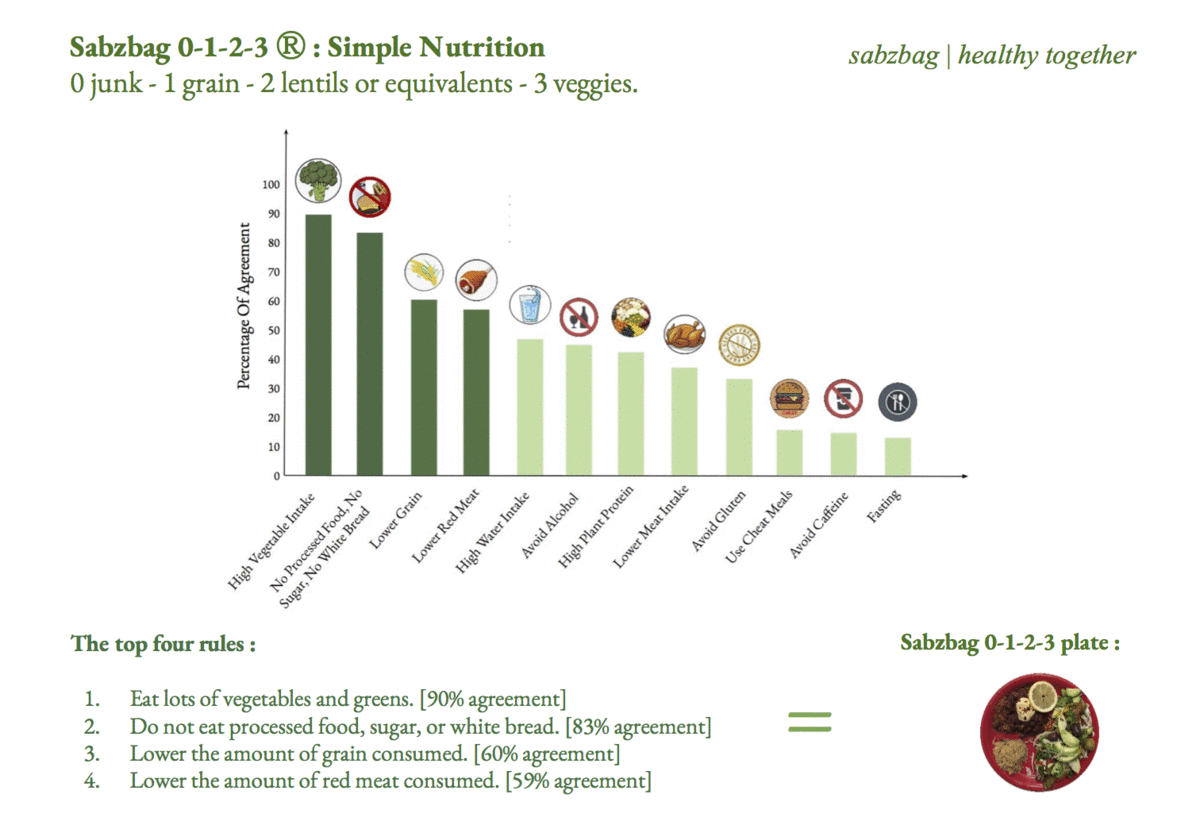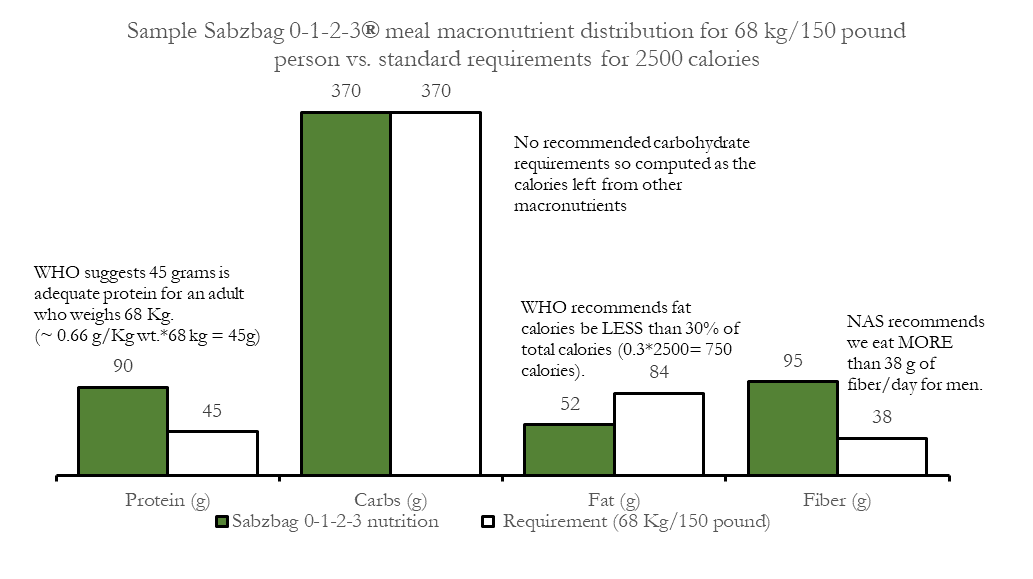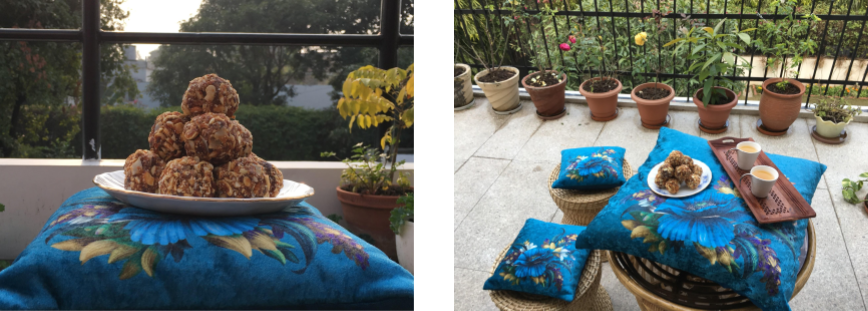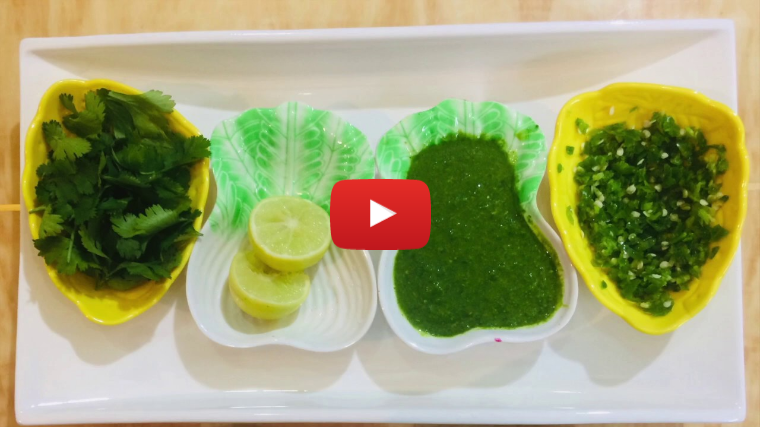Sabzbag January 2020 Newsletter |
|
|
|
Happy Sabzbag 0-1-2-3 ® new year: our simple framework to eat healthy
|
|
|
|
New year. New resolutions! More than 50% of Americans wanted to eat healthier this year. Yet as we know from previous years, it is difficult to stick to our resolutions and by the middle of the year, many of us give up in the face of daily stress. To improve the chances of fulfilling our good intentions, one of our wise readers told us to keep the resolution simple and powerful - simple enough to remember and use in almost any circumstance, and capable of delivering powerful results in tough real-life situations. Accordingly, in this issue we will introduce the one-line 0-1-2-3 nutrition framework that has helped a lot of us and have one of our members share her story of using this framework to get back in shape post-pregnancy as a busy professional.
|
 |
|
|
Figure 1: The Sabzbag 0-1-2-3 ® meal explained. |
|
|
How do we get to the Sabzbag 0 (junk) - 1 (serving of whole grain) - 2 (legumes or equivalent) - 3 (vegetables and greens) framework for a healthy meal? Last issue, we found that 50 popular nutrition books (such as "The Blue Zones Solution", "The Paleo Diet", "The 4-Hour Body", "The China Study") and Eat-Lancet metastudy of more than 350 peer reviewed academic articles all agreed on four main principles:
1) Do not eat processed food, sugar or white bread => 0 servings of junk
2) Lower the amount of grain consumed => 1 serving of grain 3) Lower the amount of red meat consumed => 2 servings of legumes or equivalents*. 4) Eat lots of vegetables and greens => 3 servings of vegetables
This is a simple sketch of how we got the Sabzbag 0 -1- 2- 3 ® framework for a healthy meal. The concept is simple enough but is it powerful? Can it really deliver adequate nutrition? Happily and surprisingly, the answer is yes which we illustrate with an example in the next section.
Delivering the essential macronutrients In this section, we take the example of a 68Kg/150-pound person who wishes to consume about 2500 calories. For this person, three Sabzbag 0-1-2-3® meals in a day will total about 0 servings of junk, 3 servings of whole grain, 6 servings of legumes or plant protein, and 9 servings of vegetables. Typically, people will also consume 3 to 6 servings of fruits and about 1-2 servings of healthy fats (such as avocado or nuts) depending on their appetite and taste, and also drink about 2 liters of water. The reason we do not address the fruits and healthy fat explicitly in the framework is that as long as we have a "reasonable amount" it does not matter. Avoiding junk, eating 3X as many vegetables as grains and 2X as many legumes or equivalents is what delivers the results and that is exactly what most experts agree upon. Also, here a serving is about the size of a fist or about 100 grams and the weight or grains and legumes are cooked weight.
As figure 2 shows, the total protein delivered is quite a bit higher than the 45 grams median protein requirement suggested by the WHO report, (and even the safe protein requirement of 54 grams in the same report in table 46), and the fiber delivered is considerably higher than the 38 grams per day recommended for men by the National Academy of Sciences (NAS) Dietary Reference report.
The NAS report (pp 63) also says that more fiber can help“attenuate the insulin response and thus be protective against type 2 diabetes" and that the consumption of fiber “can cause an extended feeling of fullness.” Specifically, "strongest data are for oat products and beans in decreasing blood lipid concentrations and decreasing the risk of coronary heart disease." (pp 365).
Thus our whole grain, legume and veggie mix can do wonders! |
 |
|
|
Figure 2: The Sabzbag 0-1-2-3 ® meal macronutrients satisfy the standard requirements |
|
|
Crucial questions In this section we discuss the typical questions we get including the protein question. Please do send us whatever other questions/comments you have.
*The typical protein questions. In our interactions there are two main questions that we get, the first, typically from our North American friends, is some version of why eat primarily plant protein and whether it can adequately satisfy our body's requirements and the second typically from our Indian friends and relatives as to why we should eat more protein as compared to grain.
(i) Can plants really be a good primary protein source? For the first question on the efficacy and sufficiency of plant protein we refer back to the EAT-Lancet study which itself is an extensive meta-study of more than 350+ peer reviewed research papers. The study says that replacing animal proteins with plant protein helps us thrive and lowers the risk of dying. Specifically: "randomised clinical trials supports the conclusion, with a high level of certainty, that dietary patterns with the following characteristics promote low risk of major chronic disease and overall wellbeing: (1) protein sources primarily from plants, including soy foods, other legumes, and nuts, fish or alternative sources of omega-3 fatty acids several times per week with optional modest consumption of poultry and eggs, and low intakes of red meat, if any, especially processed meat." The Lancet, Vol 393 February 2, 2019, page 459.
(ii) Why more protein than grain? For the second question on why eat more (mostly plant) protein than grains we go back to the same EAT-Lancet study which also says that substituting protein for excessive starch and sugar seemed to reduce blood pressure. Specifically: "Protein can have indirect beneficial metabolic effects by replacing excessive carbohydrate intake, especially if this intake is refined starch and sugar. In a large controlled feeding trial, replacing carbohydrate isocalorically with protein reduced blood pressure and blood lipid concentrations." The Lancet, Vol 393 February 2, 2019, page 454.
But what if I really like dairy? No problem! No one is forcing you to be vegan here - some of us enjoy our cheese too! Just cut out the red meat. For the rest- the cheese or other dairy related stuff simply does not count positively or negatively in the meal. You can also play around with occasionally substituting more legumes and see how you like it.
What if I want to eat more or less? The main thing is to keep close to the ratio in the framework. For example, if you are a big powerlifter, you can consume 2 meals that are 0-1-2-3 each which would make your meal 0-2-4-6 which keeps the ratios. But if you end up eating 0-1-2.5- 3.5 since you feel like eating more protein- no problem! Simply being close to these ratios delivers most of the value.
How can I personalize this nutrition framework? As mentioned above, the simplest framing captured in the 0 (junk) - 1 (serving of whole grain) - 2 (legumes or equivalent) - 3 (vegetables and greens) delivers most of the value for most people most of the time. Occasionally, there may be some particular needs - say for an athlete looking to drop weight before competition or an older person wanting to focus on an anti-inflammatory diet to mitigate arthritic pain - for which we can leverage our team's nutrition and medical knowledge as well as the person's data and our machine learning algorithms to suggest some specific and typically small deviations.
|
|
|
|
|
|
The Date Laddoo Recipe: 0 sugar, 0 flour and maximum taste |
In India tea is incomplete without sweet or savoury snacks. But going on a date looking rounded like a laddoo (or a donut) is a no no! So sabzbag came up with the date based laddoo to accompany tea during the event we did in Chandigarh at the Senior Citizen Community Center. 0 sugar, 0 flour and maximum taste! We heard reports that loving husbands stole the laddoos and ate them before their wives could get it. Um, so that's what you have to look forward to after marriage.... :)
|
|
 |
Ingredients:
- 500 grams of pitted dates
- 100 grams of almond and 150 grams of cashews.
- 50 grams of sesame seeds and 50 grams of poppy seeds
- 75 grams of unsweetened coconut flakes
- 30 grams of oat powder
Recipe:
- Dry roast all the ingredients separately except the dates. We set the temperature to 540 degree celsius for 1 - 2 minutes.
- Heat up the dates in a non-stick pan at medium heat until it attains a thick paste like consistency.
- Add all the nuts, seeds and oats into the pan and mix.
- Turn off the heat, grease your palms with oil and make balls out of the nutty paste in the pan.
You can play with the proportions of nuts and dates to get a consistency and texture that you like. Optionally you can add orange zest or cardamom powder to give it some citrus flavour or spice. |
|
|
|
|
Savory video: the desi hacks edition
Since we were just in India, discover how to cheat your tongue desi ishtyle when you are craving something savory. |
 |
|
|
|
|
Community Corner: Sara, a busy professional gets back in shape post-pregnancy using the Sabzbag 0-1-2-3 ® nutrition framework
|
About me I am a quantitative research analyst for an asset manager - a job that is quite fulfilling but demanding. Still, I have always led an active lifestyle and before pregnancy I used to work out 2 to 3 times per week doing either Brazilian jiu jitsu, weight lifting or swimming and I made sure to hit 10K steps every day.
Before pregnancy Altogether with this lifestyle I was 117lbs at 5'5" before pregnancy. After I found out the wonderful news of having a baby, I had to stop training jiu-jitsu 3 months into the pregnancy. My workouts became limited to once a week yoga and occasional swimming thanks to working full-time, harsh Canadian winters and not having a swimming pool or gym at my residence, then. Also, the number of steps I walked per day decreased gradually to 2k per day towards the end of my pregnancy.
I did not have the energy to follow any complicated diet plans and just tried to follow the Sabzbag 0-1-2-3 ® nutrition plan. I satisfied my cravings with fruits- citrus fruits for sour and mostly banana and dates for my sweet tooth. Also, while I did not keep any junk at home but interestingly by following the 0-1-2-3 framework I did not really even crave it much. During those 9 months I gained 35lbs and hit 152lbs before delivery.
|
|
|
|
 |
Pre-pregnancy |
|
|
 |
9 months pregnant |
|
|
 |
1 month postpartum |
|
|
 |
6 months postpartum |
|
|
|
|
|
After pregnancy Natural delivery, exclusively breastfeeding, sleep deprivation, and working 24/7 to take care of infant all played a role in my postpartum weight loss. My workout postpartum was limited to taking long walks with my baby every day. I also did occasional specialty workouts including drilling bjj technique (very carefully), mommy and baby weight lifting, swimming, and yoga but unfortunately the overall frequency was only about once a week. The Sabzbag community, chat room, it’s tracking app and mostly the simple 0-1-2-3 idea helped me in maintaining the healthy diet postpartum.
I did not impose any more restrictions and also had occasional treats, ice cream and chocolate while night time feeding etc. but tracked my overall nutrition using the Sabzbag app. Thankfully, I lost all 35lbs I gained during pregnancy in only 6 months, hit the same 117lbs of pre-pregnancy and have easily maintained it 9 months post baby. I did lose some muscle because of not working out but plan to get it back as my baby gets older! Overall, I am very thankful to the Sabzbag 0-1-2-3 ® nutrition concept since I could easily remember it, follow it in a stressful time and it delivered! |
|
|
|
|
Our metrics Last time we shared the progress of our group as a whole based on the idea that social interaction boosts health performance and health metrics we track. One month later, Christmas, New Year and globetrotting have taken their toll on our scores, but thanks to the previous six months we've established a strong baseline and none of us feel the classic post-holiday guilt. Miraculously, none of us gained much weight but we definitely did not improve. So, to continue to keep ourselves accountable and share the real-life travails of living healthy we will keep sharing how we are doing. Check back in and give us feedback! |
|
|
|
|
|
We will never spam you or sell your data to anyone. Ever. Unsubscribe at anytime. Feel free to forward to friends. |
| Sign up for our newsletter |
|
|
|
|